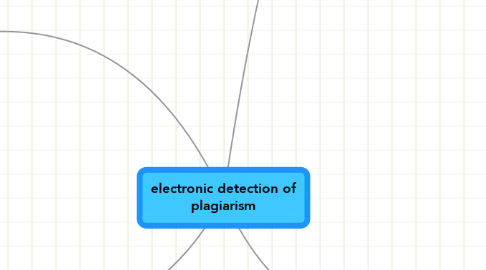
1. software/ systems in use
1.1. type of detection
1.1.1. collusion
1.1.2. copying from internet
1.1.2.1. Atkinson & Yeoh 2008
1.1.2.2. Culwin & Lancaster 2004
1.1.3. both collusion and internet copying
1.1.3.1. Butakov & Scherbinin
1.1.3.2. Knight & Bimber
1.1.3.3. Knight, Alermoth & Bimber 2004 conf
1.1.3.4. Barrie & Presti 1996
1.1.4. overall reviews
1.1.4.1. VAIL 200?
1.1.4.2. McKeever 2006
1.1.4.3. briggs 2008
1.1.4.4. Bull 2001
1.1.5. paraphrasing/ ideas
1.1.6. Chester 2001
1.2. comparison of usability
1.3. comparison of accuracy
1.3.1. Weber-Wuff 2008a, b
1.3.2. limitations
1.3.2.1. Purdy 2005
1.3.2.2. not searching certain sources
1.3.2.2.1. Atkinson & Yeoh 2008
1.3.2.3. legal problems
1.3.2.3.1. Purdy 2005
1.3.2.4. Royce 2003
1.3.2.5. Warn 2006
1.3.3. Braumoeller & Gaines 2001
1.4. detection rates
1.4.1. Braumoeller & Gaines 2001
2. impact
2.1. uptake by institutions
2.1.1. UK
2.1.2. USA
2.1.2.1. Auer & Krupar 2001
2.1.3. Australia
2.1.3.1. Mulcahy & Goodacre 2004
2.2. drivers for uptake?
2.2.1. external examiners
2.2.2. standards
2.2.3. norms
2.3. policy and penalties
2.3.1. AMBER 1/2
2.4. consistency of practice/ quality assurance?
2.4.1. Deech
2.5. public effects
2.5.1. adverse publicity
2.5.1.1. Schemo 2001
2.5.2. effects of penalties on students
2.5.2.1. Sutherland-smith & Carr 2005
2.5.2.2. Johnson 2004
3. implementation
3.1. pilot studies
3.1.1. Mulcahy & Goodacre 2004
3.1.2. Evans 2006
3.2. institutional roll outs
3.2.1. Badge paper
3.2.2. Heap & Woolls, 2006
3.3. guidelines for use by staff
3.3.1. lindsay 2003
3.4. perceptions of staff
3.4.1. perceived benefits
3.4.1.1. increased detection
3.4.1.2. prevention of pl
3.4.1.3. decrease in workload
3.4.1.4. increase in quality of work
3.4.2. perceived problems/ barriers
3.4.2.1. increase in workload
3.4.2.1.1. Mulcahy & Goodacre 2004
3.4.2.1.2. Sutherland-smith & Carr 2005
3.4.2.1.3. Atkinson & Yeoh 2008
3.4.2.1.4. warn 2006
3.4.2.1.5. evans 2006
3.4.2.2. increase in cases/ cases take time to process thru disciplinary
3.4.2.2.1. Atkinson & Yeoh
3.4.2.3. not improving work just avoiding copying
3.4.2.4. not working properly
3.4.2.4.1. Atkinson & Yeoh 2008
3.4.3. training of staff
3.4.3.1. staff need training in interpretation of OR
3.4.3.1.1. Mulcahy & Goodacre 2004
3.4.3.1.2. Goddard & Rudzki 2005
3.4.4. ethical considerations
3.4.4.1. Jenson & Castell 2004
3.5. perceptions of students
3.5.1. self-reported levels of cheating
3.5.1.1. McCabe etc..
3.5.1.2. Szabo & Underwood 2004
3.5.1.3. evans 2006
3.5.1.4. Franklyn-Stokes & Newstead 1995
3.5.2. perception of being caught
3.5.3. concern at being unjustly accused or accidental plagiarism
3.5.3.1. martin, stubbs and troop 2006
3.5.4. ease of use/ electronic handing in
3.5.4.1. Atkinson & Yeoh 2008
3.5.4.2. dahl 2007
3.5.5. copyright concerns
3.5.5.1. Purdy 2005
3.5.6. student view on seeing OR
3.5.6.1. Dahl 2007
4. mode of use
4.1. formative
4.1.1. student led: using own systems to check work
4.1.1.1. viper/ scanmyessay.com
4.1.1.2. write check (TII)
4.1.1.3. online tutorials
4.1.1.3.1. Jackson 2006
4.1.2. tutor led
4.1.2.1. resubmission of work/ using drafts
4.1.2.1.1. tutor supported
4.1.2.1.2. student use
4.2. summative
4.2.1. whole class submission
4.2.1.1. results demonstrated to students, next assignment decrease in plagiarism
4.2.1.1.1. Braumoeller & Gaines 2001
4.2.1.1.2. Ledwith & Risquez 2008
4.2.2. suspect cases only
4.2.3. resubmission
4.2.3.1. Barrett & Malcolm 2006
4.3. prevention/ deterrent
4.3.1. perception of punishment as education
4.3.1.1. Sutherland-smith & Carr 2005
4.3.1.2. Johnson 2004
4.3.1.3. Bennett 2005
4.3.2. perception of risk/benefit analysis by students dependent on penalties
4.3.2.1. Woessner 2004
4.3.2.2. martin, stubbs and troop 2006
4.3.3. rates of plagiarism observed to decrease over time
4.3.3.1. Culwin 2006 conf
